Comprehensive Brand Management Report: M&S Strategies and Analysis
VerifiedAdded on 2023/01/13
|21
|7479
|100
Report
AI Summary
This report delves into the core concepts of brand management, using Marks & Spencer (M&S) as a case study. It begins by defining brand management and its importance as a marketing tool, exploring the key components of a successful brand strategy, including brand equity, brand pyramids, and the advantages and disadvantages of branding. The report then examines brand portfolio management, brand hierarchy, and brand equity management strategies. Furthermore, it analyzes how brands are managed collaboratively and in partnership at both domestic and global levels, evaluating techniques used for leveraging and extending brands. The report also assesses various techniques for measuring and managing brand value, providing organizational examples. The analysis includes an evaluation of different applications for managing and measuring brand value, culminating in a critical evaluation of branding within an organizational context, supported by justified evidence.
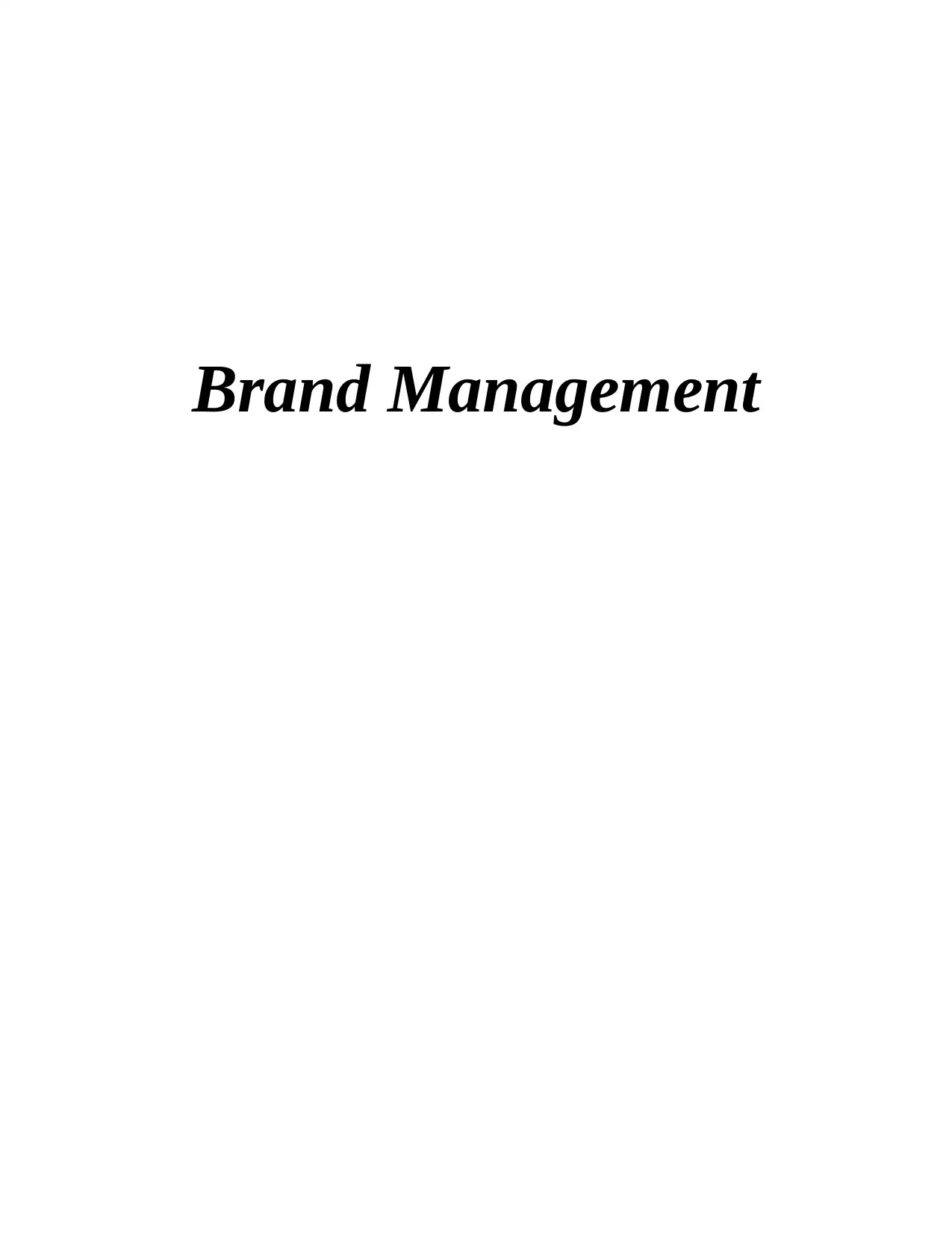
Brand Management
Paraphrase This Document
Need a fresh take? Get an instant paraphrase of this document with our AI Paraphraser
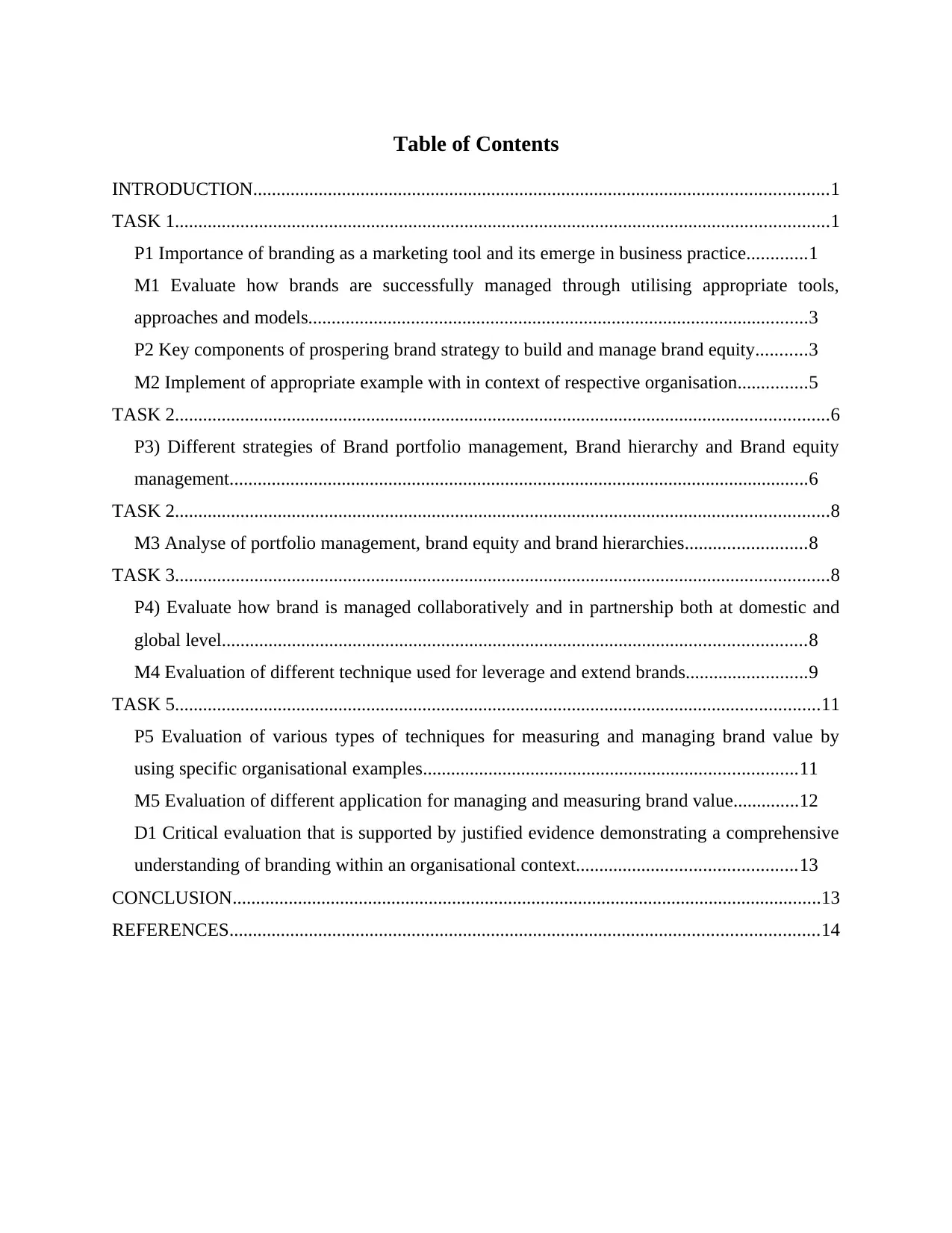
Table of Contents
INTRODUCTION...........................................................................................................................1
TASK 1............................................................................................................................................1
P1 Importance of branding as a marketing tool and its emerge in business practice.............1
M1 Evaluate how brands are successfully managed through utilising appropriate tools,
approaches and models...........................................................................................................3
P2 Key components of prospering brand strategy to build and manage brand equity...........3
M2 Implement of appropriate example with in context of respective organisation...............5
TASK 2............................................................................................................................................6
P3) Different strategies of Brand portfolio management, Brand hierarchy and Brand equity
management............................................................................................................................6
TASK 2............................................................................................................................................8
M3 Analyse of portfolio management, brand equity and brand hierarchies..........................8
TASK 3............................................................................................................................................8
P4) Evaluate how brand is managed collaboratively and in partnership both at domestic and
global level.............................................................................................................................8
M4 Evaluation of different technique used for leverage and extend brands..........................9
TASK 5..........................................................................................................................................11
P5 Evaluation of various types of techniques for measuring and managing brand value by
using specific organisational examples................................................................................11
M5 Evaluation of different application for managing and measuring brand value..............12
D1 Critical evaluation that is supported by justified evidence demonstrating a comprehensive
understanding of branding within an organisational context...............................................13
CONCLUSION..............................................................................................................................13
REFERENCES..............................................................................................................................14
INTRODUCTION...........................................................................................................................1
TASK 1............................................................................................................................................1
P1 Importance of branding as a marketing tool and its emerge in business practice.............1
M1 Evaluate how brands are successfully managed through utilising appropriate tools,
approaches and models...........................................................................................................3
P2 Key components of prospering brand strategy to build and manage brand equity...........3
M2 Implement of appropriate example with in context of respective organisation...............5
TASK 2............................................................................................................................................6
P3) Different strategies of Brand portfolio management, Brand hierarchy and Brand equity
management............................................................................................................................6
TASK 2............................................................................................................................................8
M3 Analyse of portfolio management, brand equity and brand hierarchies..........................8
TASK 3............................................................................................................................................8
P4) Evaluate how brand is managed collaboratively and in partnership both at domestic and
global level.............................................................................................................................8
M4 Evaluation of different technique used for leverage and extend brands..........................9
TASK 5..........................................................................................................................................11
P5 Evaluation of various types of techniques for measuring and managing brand value by
using specific organisational examples................................................................................11
M5 Evaluation of different application for managing and measuring brand value..............12
D1 Critical evaluation that is supported by justified evidence demonstrating a comprehensive
understanding of branding within an organisational context...............................................13
CONCLUSION..............................................................................................................................13
REFERENCES..............................................................................................................................14
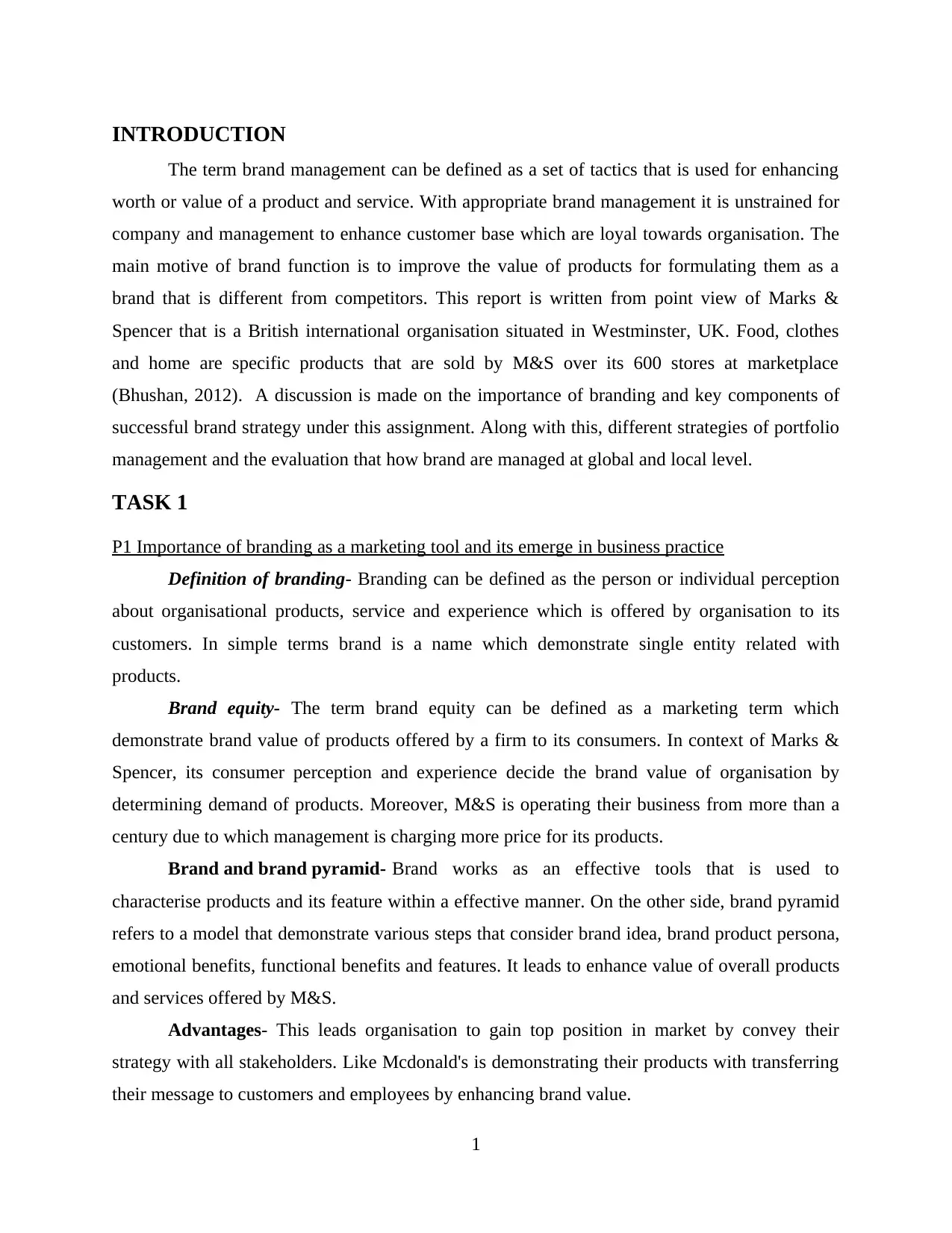
INTRODUCTION
The term brand management can be defined as a set of tactics that is used for enhancing
worth or value of a product and service. With appropriate brand management it is unstrained for
company and management to enhance customer base which are loyal towards organisation. The
main motive of brand function is to improve the value of products for formulating them as a
brand that is different from competitors. This report is written from point view of Marks &
Spencer that is a British international organisation situated in Westminster, UK. Food, clothes
and home are specific products that are sold by M&S over its 600 stores at marketplace
(Bhushan, 2012). A discussion is made on the importance of branding and key components of
successful brand strategy under this assignment. Along with this, different strategies of portfolio
management and the evaluation that how brand are managed at global and local level.
TASK 1
P1 Importance of branding as a marketing tool and its emerge in business practice
Definition of branding- Branding can be defined as the person or individual perception
about organisational products, service and experience which is offered by organisation to its
customers. In simple terms brand is a name which demonstrate single entity related with
products.
Brand equity- The term brand equity can be defined as a marketing term which
demonstrate brand value of products offered by a firm to its consumers. In context of Marks &
Spencer, its consumer perception and experience decide the brand value of organisation by
determining demand of products. Moreover, M&S is operating their business from more than a
century due to which management is charging more price for its products.
Brand and brand pyramid- Brand works as an effective tools that is used to
characterise products and its feature within a effective manner. On the other side, brand pyramid
refers to a model that demonstrate various steps that consider brand idea, brand product persona,
emotional benefits, functional benefits and features. It leads to enhance value of overall products
and services offered by M&S.
Advantages- This leads organisation to gain top position in market by convey their
strategy with all stakeholders. Like Mcdonald's is demonstrating their products with transferring
their message to customers and employees by enhancing brand value.
1
The term brand management can be defined as a set of tactics that is used for enhancing
worth or value of a product and service. With appropriate brand management it is unstrained for
company and management to enhance customer base which are loyal towards organisation. The
main motive of brand function is to improve the value of products for formulating them as a
brand that is different from competitors. This report is written from point view of Marks &
Spencer that is a British international organisation situated in Westminster, UK. Food, clothes
and home are specific products that are sold by M&S over its 600 stores at marketplace
(Bhushan, 2012). A discussion is made on the importance of branding and key components of
successful brand strategy under this assignment. Along with this, different strategies of portfolio
management and the evaluation that how brand are managed at global and local level.
TASK 1
P1 Importance of branding as a marketing tool and its emerge in business practice
Definition of branding- Branding can be defined as the person or individual perception
about organisational products, service and experience which is offered by organisation to its
customers. In simple terms brand is a name which demonstrate single entity related with
products.
Brand equity- The term brand equity can be defined as a marketing term which
demonstrate brand value of products offered by a firm to its consumers. In context of Marks &
Spencer, its consumer perception and experience decide the brand value of organisation by
determining demand of products. Moreover, M&S is operating their business from more than a
century due to which management is charging more price for its products.
Brand and brand pyramid- Brand works as an effective tools that is used to
characterise products and its feature within a effective manner. On the other side, brand pyramid
refers to a model that demonstrate various steps that consider brand idea, brand product persona,
emotional benefits, functional benefits and features. It leads to enhance value of overall products
and services offered by M&S.
Advantages- This leads organisation to gain top position in market by convey their
strategy with all stakeholders. Like Mcdonald's is demonstrating their products with transferring
their message to customers and employees by enhancing brand value.
1
⊘ This is a preview!⊘
Do you want full access?
Subscribe today to unlock all pages.

Trusted by 1+ million students worldwide
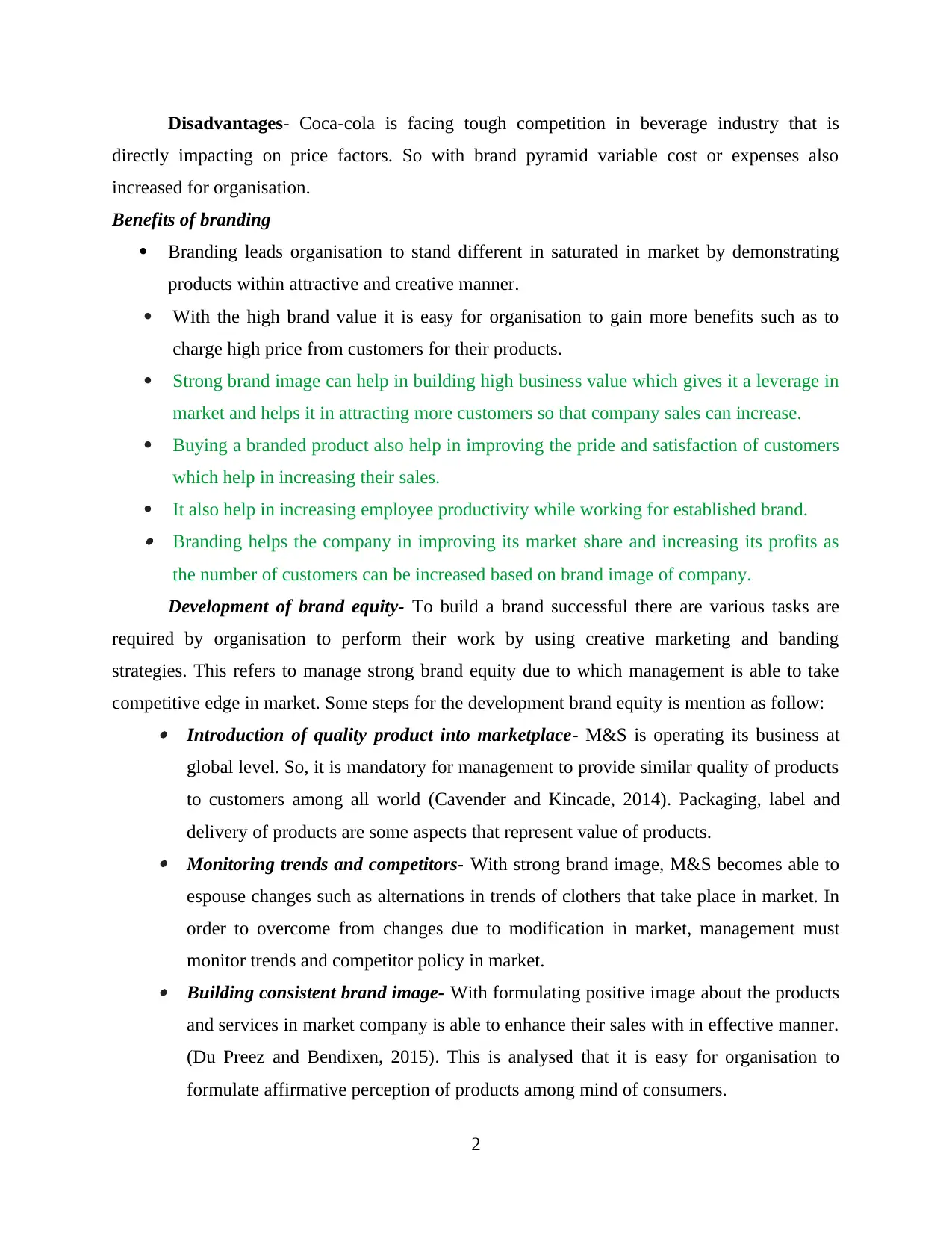
Disadvantages- Coca-cola is facing tough competition in beverage industry that is
directly impacting on price factors. So with brand pyramid variable cost or expenses also
increased for organisation.
Benefits of branding
Branding leads organisation to stand different in saturated in market by demonstrating
products within attractive and creative manner.
With the high brand value it is easy for organisation to gain more benefits such as to
charge high price from customers for their products.
Strong brand image can help in building high business value which gives it a leverage in
market and helps it in attracting more customers so that company sales can increase.
Buying a branded product also help in improving the pride and satisfaction of customers
which help in increasing their sales.
It also help in increasing employee productivity while working for established brand. Branding helps the company in improving its market share and increasing its profits as
the number of customers can be increased based on brand image of company.
Development of brand equity- To build a brand successful there are various tasks are
required by organisation to perform their work by using creative marketing and banding
strategies. This refers to manage strong brand equity due to which management is able to take
competitive edge in market. Some steps for the development brand equity is mention as follow:
Introduction of quality product into marketplace- M&S is operating its business at
global level. So, it is mandatory for management to provide similar quality of products
to customers among all world (Cavender and Kincade, 2014). Packaging, label and
delivery of products are some aspects that represent value of products.
Monitoring trends and competitors- With strong brand image, M&S becomes able to
espouse changes such as alternations in trends of clothers that take place in market. In
order to overcome from changes due to modification in market, management must
monitor trends and competitor policy in market.
Building consistent brand image- With formulating positive image about the products
and services in market company is able to enhance their sales with in effective manner.
(Du Preez and Bendixen, 2015). This is analysed that it is easy for organisation to
formulate affirmative perception of products among mind of consumers.
2
directly impacting on price factors. So with brand pyramid variable cost or expenses also
increased for organisation.
Benefits of branding
Branding leads organisation to stand different in saturated in market by demonstrating
products within attractive and creative manner.
With the high brand value it is easy for organisation to gain more benefits such as to
charge high price from customers for their products.
Strong brand image can help in building high business value which gives it a leverage in
market and helps it in attracting more customers so that company sales can increase.
Buying a branded product also help in improving the pride and satisfaction of customers
which help in increasing their sales.
It also help in increasing employee productivity while working for established brand. Branding helps the company in improving its market share and increasing its profits as
the number of customers can be increased based on brand image of company.
Development of brand equity- To build a brand successful there are various tasks are
required by organisation to perform their work by using creative marketing and banding
strategies. This refers to manage strong brand equity due to which management is able to take
competitive edge in market. Some steps for the development brand equity is mention as follow:
Introduction of quality product into marketplace- M&S is operating its business at
global level. So, it is mandatory for management to provide similar quality of products
to customers among all world (Cavender and Kincade, 2014). Packaging, label and
delivery of products are some aspects that represent value of products.
Monitoring trends and competitors- With strong brand image, M&S becomes able to
espouse changes such as alternations in trends of clothers that take place in market. In
order to overcome from changes due to modification in market, management must
monitor trends and competitor policy in market.
Building consistent brand image- With formulating positive image about the products
and services in market company is able to enhance their sales with in effective manner.
(Du Preez and Bendixen, 2015). This is analysed that it is easy for organisation to
formulate affirmative perception of products among mind of consumers.
2
Paraphrase This Document
Need a fresh take? Get an instant paraphrase of this document with our AI Paraphraser
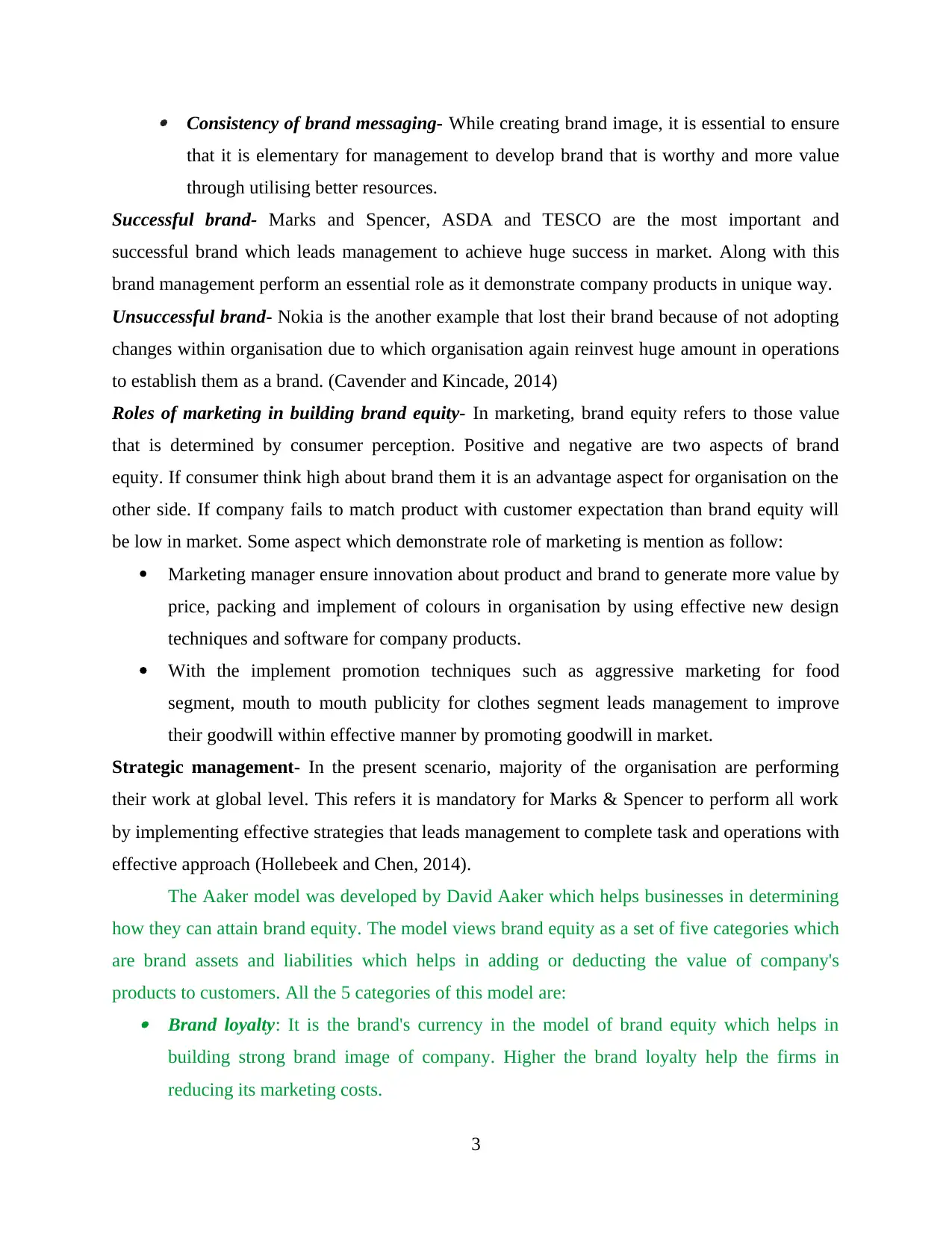
Consistency of brand messaging- While creating brand image, it is essential to ensure
that it is elementary for management to develop brand that is worthy and more value
through utilising better resources.
Successful brand- Marks and Spencer, ASDA and TESCO are the most important and
successful brand which leads management to achieve huge success in market. Along with this
brand management perform an essential role as it demonstrate company products in unique way.
Unsuccessful brand- Nokia is the another example that lost their brand because of not adopting
changes within organisation due to which organisation again reinvest huge amount in operations
to establish them as a brand. (Cavender and Kincade, 2014)
Roles of marketing in building brand equity- In marketing, brand equity refers to those value
that is determined by consumer perception. Positive and negative are two aspects of brand
equity. If consumer think high about brand them it is an advantage aspect for organisation on the
other side. If company fails to match product with customer expectation than brand equity will
be low in market. Some aspect which demonstrate role of marketing is mention as follow:
Marketing manager ensure innovation about product and brand to generate more value by
price, packing and implement of colours in organisation by using effective new design
techniques and software for company products.
With the implement promotion techniques such as aggressive marketing for food
segment, mouth to mouth publicity for clothes segment leads management to improve
their goodwill within effective manner by promoting goodwill in market.
Strategic management- In the present scenario, majority of the organisation are performing
their work at global level. This refers it is mandatory for Marks & Spencer to perform all work
by implementing effective strategies that leads management to complete task and operations with
effective approach (Hollebeek and Chen, 2014).
The Aaker model was developed by David Aaker which helps businesses in determining
how they can attain brand equity. The model views brand equity as a set of five categories which
are brand assets and liabilities which helps in adding or deducting the value of company's
products to customers. All the 5 categories of this model are: Brand loyalty: It is the brand's currency in the model of brand equity which helps in
building strong brand image of company. Higher the brand loyalty help the firms in
reducing its marketing costs.
3
that it is elementary for management to develop brand that is worthy and more value
through utilising better resources.
Successful brand- Marks and Spencer, ASDA and TESCO are the most important and
successful brand which leads management to achieve huge success in market. Along with this
brand management perform an essential role as it demonstrate company products in unique way.
Unsuccessful brand- Nokia is the another example that lost their brand because of not adopting
changes within organisation due to which organisation again reinvest huge amount in operations
to establish them as a brand. (Cavender and Kincade, 2014)
Roles of marketing in building brand equity- In marketing, brand equity refers to those value
that is determined by consumer perception. Positive and negative are two aspects of brand
equity. If consumer think high about brand them it is an advantage aspect for organisation on the
other side. If company fails to match product with customer expectation than brand equity will
be low in market. Some aspect which demonstrate role of marketing is mention as follow:
Marketing manager ensure innovation about product and brand to generate more value by
price, packing and implement of colours in organisation by using effective new design
techniques and software for company products.
With the implement promotion techniques such as aggressive marketing for food
segment, mouth to mouth publicity for clothes segment leads management to improve
their goodwill within effective manner by promoting goodwill in market.
Strategic management- In the present scenario, majority of the organisation are performing
their work at global level. This refers it is mandatory for Marks & Spencer to perform all work
by implementing effective strategies that leads management to complete task and operations with
effective approach (Hollebeek and Chen, 2014).
The Aaker model was developed by David Aaker which helps businesses in determining
how they can attain brand equity. The model views brand equity as a set of five categories which
are brand assets and liabilities which helps in adding or deducting the value of company's
products to customers. All the 5 categories of this model are: Brand loyalty: It is the brand's currency in the model of brand equity which helps in
building strong brand image of company. Higher the brand loyalty help the firms in
reducing its marketing costs.
3
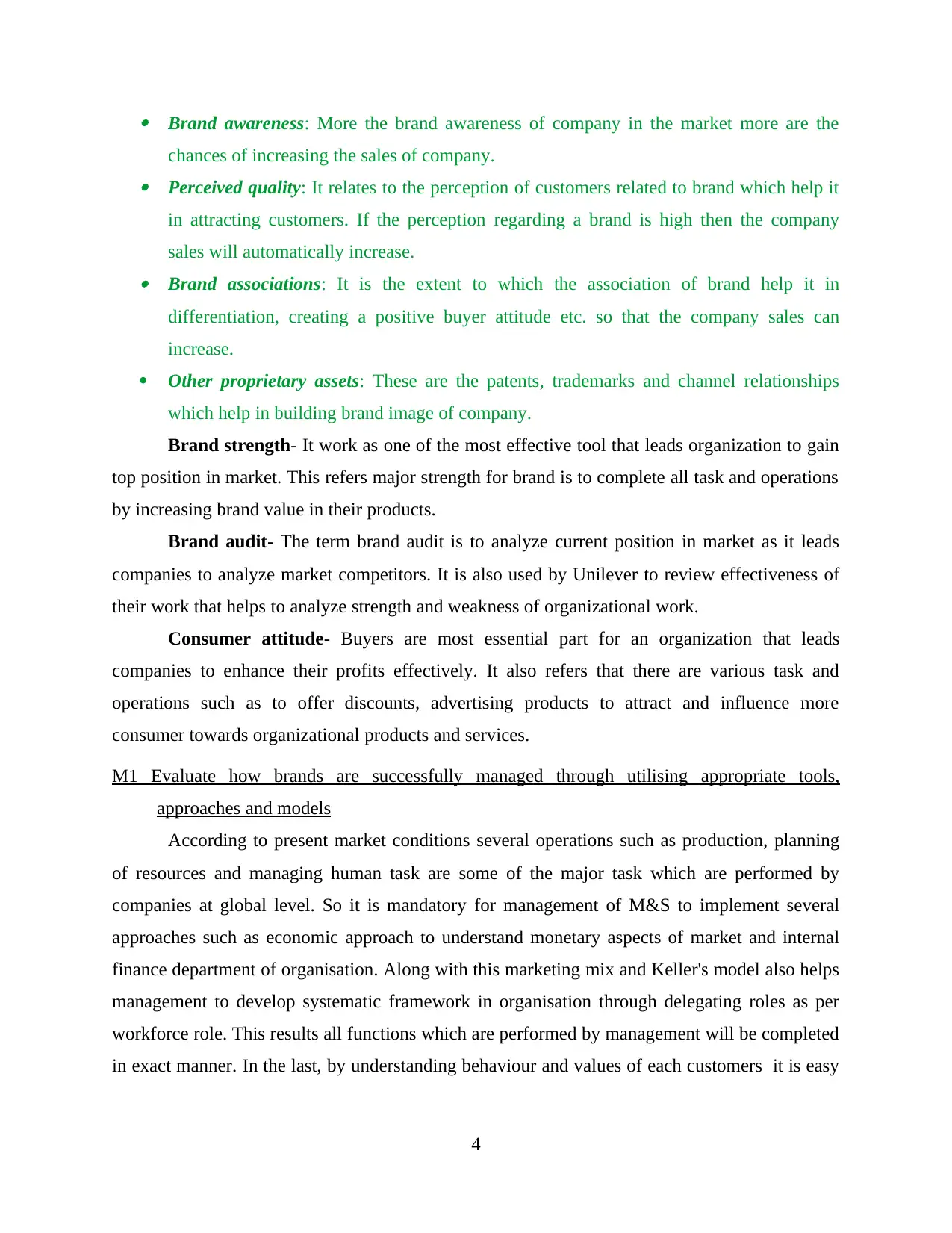
Brand awareness: More the brand awareness of company in the market more are the
chances of increasing the sales of company. Perceived quality: It relates to the perception of customers related to brand which help it
in attracting customers. If the perception regarding a brand is high then the company
sales will automatically increase. Brand associations: It is the extent to which the association of brand help it in
differentiation, creating a positive buyer attitude etc. so that the company sales can
increase.
Other proprietary assets: These are the patents, trademarks and channel relationships
which help in building brand image of company.
Brand strength- It work as one of the most effective tool that leads organization to gain
top position in market. This refers major strength for brand is to complete all task and operations
by increasing brand value in their products.
Brand audit- The term brand audit is to analyze current position in market as it leads
companies to analyze market competitors. It is also used by Unilever to review effectiveness of
their work that helps to analyze strength and weakness of organizational work.
Consumer attitude- Buyers are most essential part for an organization that leads
companies to enhance their profits effectively. It also refers that there are various task and
operations such as to offer discounts, advertising products to attract and influence more
consumer towards organizational products and services.
M1 Evaluate how brands are successfully managed through utilising appropriate tools,
approaches and models
According to present market conditions several operations such as production, planning
of resources and managing human task are some of the major task which are performed by
companies at global level. So it is mandatory for management of M&S to implement several
approaches such as economic approach to understand monetary aspects of market and internal
finance department of organisation. Along with this marketing mix and Keller's model also helps
management to develop systematic framework in organisation through delegating roles as per
workforce role. This results all functions which are performed by management will be completed
in exact manner. In the last, by understanding behaviour and values of each customers it is easy
4
chances of increasing the sales of company. Perceived quality: It relates to the perception of customers related to brand which help it
in attracting customers. If the perception regarding a brand is high then the company
sales will automatically increase. Brand associations: It is the extent to which the association of brand help it in
differentiation, creating a positive buyer attitude etc. so that the company sales can
increase.
Other proprietary assets: These are the patents, trademarks and channel relationships
which help in building brand image of company.
Brand strength- It work as one of the most effective tool that leads organization to gain
top position in market. This refers major strength for brand is to complete all task and operations
by increasing brand value in their products.
Brand audit- The term brand audit is to analyze current position in market as it leads
companies to analyze market competitors. It is also used by Unilever to review effectiveness of
their work that helps to analyze strength and weakness of organizational work.
Consumer attitude- Buyers are most essential part for an organization that leads
companies to enhance their profits effectively. It also refers that there are various task and
operations such as to offer discounts, advertising products to attract and influence more
consumer towards organizational products and services.
M1 Evaluate how brands are successfully managed through utilising appropriate tools,
approaches and models
According to present market conditions several operations such as production, planning
of resources and managing human task are some of the major task which are performed by
companies at global level. So it is mandatory for management of M&S to implement several
approaches such as economic approach to understand monetary aspects of market and internal
finance department of organisation. Along with this marketing mix and Keller's model also helps
management to develop systematic framework in organisation through delegating roles as per
workforce role. This results all functions which are performed by management will be completed
in exact manner. In the last, by understanding behaviour and values of each customers it is easy
4
⊘ This is a preview!⊘
Do you want full access?
Subscribe today to unlock all pages.

Trusted by 1+ million students worldwide
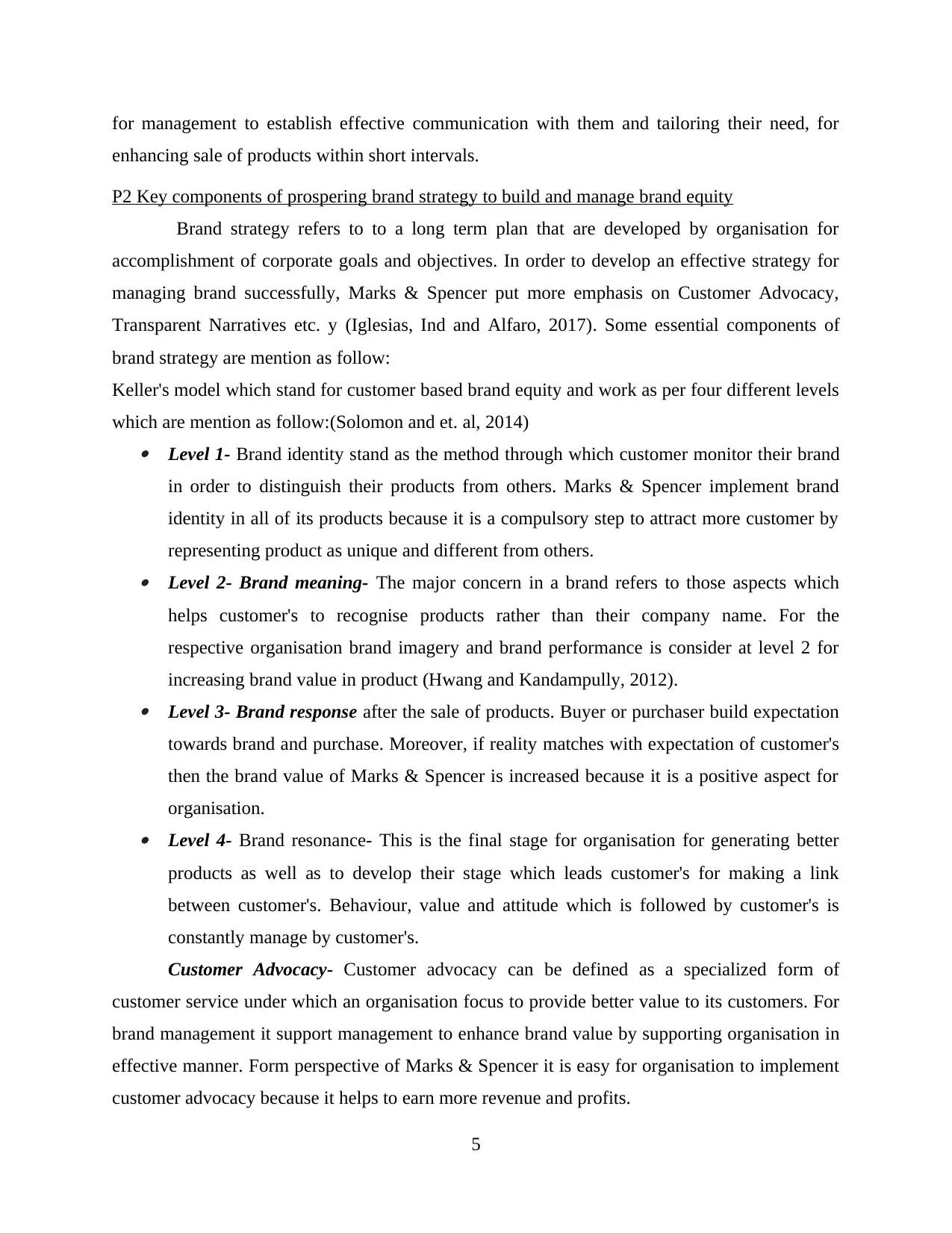
for management to establish effective communication with them and tailoring their need, for
enhancing sale of products within short intervals.
P2 Key components of prospering brand strategy to build and manage brand equity
Brand strategy refers to to a long term plan that are developed by organisation for
accomplishment of corporate goals and objectives. In order to develop an effective strategy for
managing brand successfully, Marks & Spencer put more emphasis on Customer Advocacy,
Transparent Narratives etc. y (Iglesias, Ind and Alfaro, 2017). Some essential components of
brand strategy are mention as follow:
Keller's model which stand for customer based brand equity and work as per four different levels
which are mention as follow:(Solomon and et. al, 2014) Level 1- Brand identity stand as the method through which customer monitor their brand
in order to distinguish their products from others. Marks & Spencer implement brand
identity in all of its products because it is a compulsory step to attract more customer by
representing product as unique and different from others. Level 2- Brand meaning- The major concern in a brand refers to those aspects which
helps customer's to recognise products rather than their company name. For the
respective organisation brand imagery and brand performance is consider at level 2 for
increasing brand value in product (Hwang and Kandampully, 2012). Level 3- Brand response after the sale of products. Buyer or purchaser build expectation
towards brand and purchase. Moreover, if reality matches with expectation of customer's
then the brand value of Marks & Spencer is increased because it is a positive aspect for
organisation. Level 4- Brand resonance- This is the final stage for organisation for generating better
products as well as to develop their stage which leads customer's for making a link
between customer's. Behaviour, value and attitude which is followed by customer's is
constantly manage by customer's.
Customer Advocacy- Customer advocacy can be defined as a specialized form of
customer service under which an organisation focus to provide better value to its customers. For
brand management it support management to enhance brand value by supporting organisation in
effective manner. Form perspective of Marks & Spencer it is easy for organisation to implement
customer advocacy because it helps to earn more revenue and profits.
5
enhancing sale of products within short intervals.
P2 Key components of prospering brand strategy to build and manage brand equity
Brand strategy refers to to a long term plan that are developed by organisation for
accomplishment of corporate goals and objectives. In order to develop an effective strategy for
managing brand successfully, Marks & Spencer put more emphasis on Customer Advocacy,
Transparent Narratives etc. y (Iglesias, Ind and Alfaro, 2017). Some essential components of
brand strategy are mention as follow:
Keller's model which stand for customer based brand equity and work as per four different levels
which are mention as follow:(Solomon and et. al, 2014) Level 1- Brand identity stand as the method through which customer monitor their brand
in order to distinguish their products from others. Marks & Spencer implement brand
identity in all of its products because it is a compulsory step to attract more customer by
representing product as unique and different from others. Level 2- Brand meaning- The major concern in a brand refers to those aspects which
helps customer's to recognise products rather than their company name. For the
respective organisation brand imagery and brand performance is consider at level 2 for
increasing brand value in product (Hwang and Kandampully, 2012). Level 3- Brand response after the sale of products. Buyer or purchaser build expectation
towards brand and purchase. Moreover, if reality matches with expectation of customer's
then the brand value of Marks & Spencer is increased because it is a positive aspect for
organisation. Level 4- Brand resonance- This is the final stage for organisation for generating better
products as well as to develop their stage which leads customer's for making a link
between customer's. Behaviour, value and attitude which is followed by customer's is
constantly manage by customer's.
Customer Advocacy- Customer advocacy can be defined as a specialized form of
customer service under which an organisation focus to provide better value to its customers. For
brand management it support management to enhance brand value by supporting organisation in
effective manner. Form perspective of Marks & Spencer it is easy for organisation to implement
customer advocacy because it helps to earn more revenue and profits.
5
Paraphrase This Document
Need a fresh take? Get an instant paraphrase of this document with our AI Paraphraser
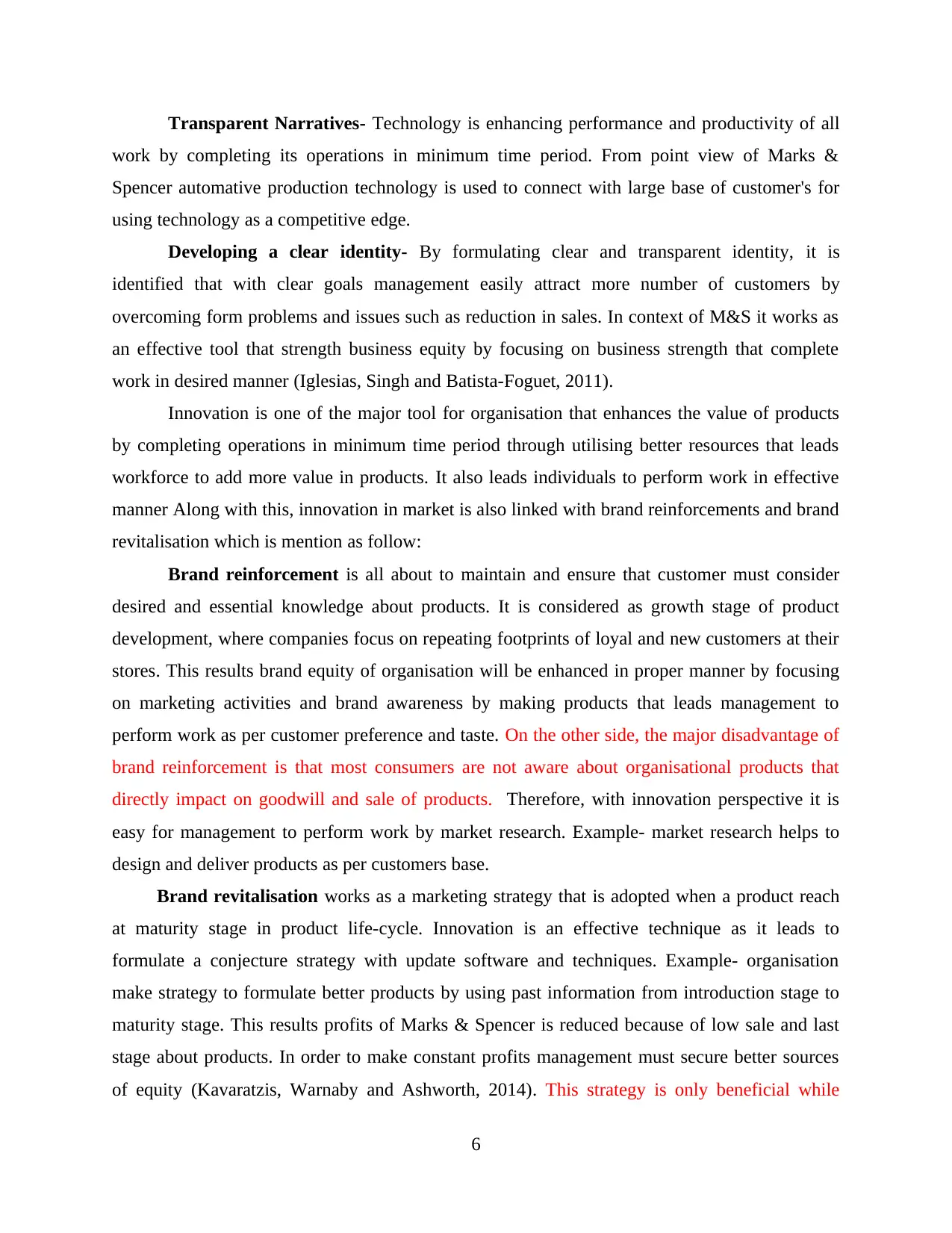
Transparent Narratives- Technology is enhancing performance and productivity of all
work by completing its operations in minimum time period. From point view of Marks &
Spencer automative production technology is used to connect with large base of customer's for
using technology as a competitive edge.
Developing a clear identity- By formulating clear and transparent identity, it is
identified that with clear goals management easily attract more number of customers by
overcoming form problems and issues such as reduction in sales. In context of M&S it works as
an effective tool that strength business equity by focusing on business strength that complete
work in desired manner (Iglesias, Singh and Batista-Foguet, 2011).
Innovation is one of the major tool for organisation that enhances the value of products
by completing operations in minimum time period through utilising better resources that leads
workforce to add more value in products. It also leads individuals to perform work in effective
manner Along with this, innovation in market is also linked with brand reinforcements and brand
revitalisation which is mention as follow:
Brand reinforcement is all about to maintain and ensure that customer must consider
desired and essential knowledge about products. It is considered as growth stage of product
development, where companies focus on repeating footprints of loyal and new customers at their
stores. This results brand equity of organisation will be enhanced in proper manner by focusing
on marketing activities and brand awareness by making products that leads management to
perform work as per customer preference and taste. On the other side, the major disadvantage of
brand reinforcement is that most consumers are not aware about organisational products that
directly impact on goodwill and sale of products. Therefore, with innovation perspective it is
easy for management to perform work by market research. Example- market research helps to
design and deliver products as per customers base.
Brand revitalisation works as a marketing strategy that is adopted when a product reach
at maturity stage in product life-cycle. Innovation is an effective technique as it leads to
formulate a conjecture strategy with update software and techniques. Example- organisation
make strategy to formulate better products by using past information from introduction stage to
maturity stage. This results profits of Marks & Spencer is reduced because of low sale and last
stage about products. In order to make constant profits management must secure better sources
of equity (Kavaratzis, Warnaby and Ashworth, 2014). This strategy is only beneficial while
6
work by completing its operations in minimum time period. From point view of Marks &
Spencer automative production technology is used to connect with large base of customer's for
using technology as a competitive edge.
Developing a clear identity- By formulating clear and transparent identity, it is
identified that with clear goals management easily attract more number of customers by
overcoming form problems and issues such as reduction in sales. In context of M&S it works as
an effective tool that strength business equity by focusing on business strength that complete
work in desired manner (Iglesias, Singh and Batista-Foguet, 2011).
Innovation is one of the major tool for organisation that enhances the value of products
by completing operations in minimum time period through utilising better resources that leads
workforce to add more value in products. It also leads individuals to perform work in effective
manner Along with this, innovation in market is also linked with brand reinforcements and brand
revitalisation which is mention as follow:
Brand reinforcement is all about to maintain and ensure that customer must consider
desired and essential knowledge about products. It is considered as growth stage of product
development, where companies focus on repeating footprints of loyal and new customers at their
stores. This results brand equity of organisation will be enhanced in proper manner by focusing
on marketing activities and brand awareness by making products that leads management to
perform work as per customer preference and taste. On the other side, the major disadvantage of
brand reinforcement is that most consumers are not aware about organisational products that
directly impact on goodwill and sale of products. Therefore, with innovation perspective it is
easy for management to perform work by market research. Example- market research helps to
design and deliver products as per customers base.
Brand revitalisation works as a marketing strategy that is adopted when a product reach
at maturity stage in product life-cycle. Innovation is an effective technique as it leads to
formulate a conjecture strategy with update software and techniques. Example- organisation
make strategy to formulate better products by using past information from introduction stage to
maturity stage. This results profits of Marks & Spencer is reduced because of low sale and last
stage about products. In order to make constant profits management must secure better sources
of equity (Kavaratzis, Warnaby and Ashworth, 2014). This strategy is only beneficial while
6
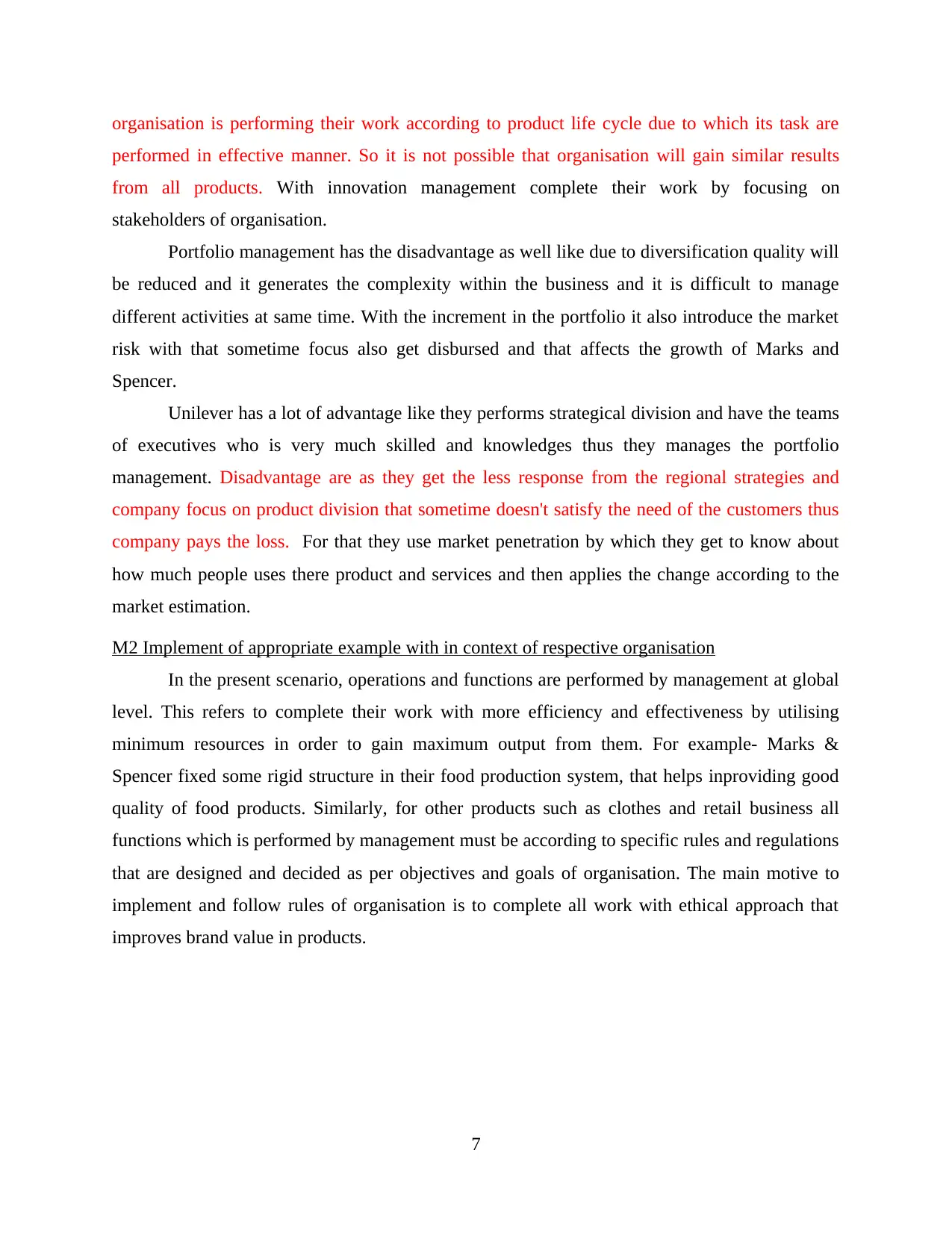
organisation is performing their work according to product life cycle due to which its task are
performed in effective manner. So it is not possible that organisation will gain similar results
from all products. With innovation management complete their work by focusing on
stakeholders of organisation.
Portfolio management has the disadvantage as well like due to diversification quality will
be reduced and it generates the complexity within the business and it is difficult to manage
different activities at same time. With the increment in the portfolio it also introduce the market
risk with that sometime focus also get disbursed and that affects the growth of Marks and
Spencer.
Unilever has a lot of advantage like they performs strategical division and have the teams
of executives who is very much skilled and knowledges thus they manages the portfolio
management. Disadvantage are as they get the less response from the regional strategies and
company focus on product division that sometime doesn't satisfy the need of the customers thus
company pays the loss. For that they use market penetration by which they get to know about
how much people uses there product and services and then applies the change according to the
market estimation.
M2 Implement of appropriate example with in context of respective organisation
In the present scenario, operations and functions are performed by management at global
level. This refers to complete their work with more efficiency and effectiveness by utilising
minimum resources in order to gain maximum output from them. For example- Marks &
Spencer fixed some rigid structure in their food production system, that helps inproviding good
quality of food products. Similarly, for other products such as clothes and retail business all
functions which is performed by management must be according to specific rules and regulations
that are designed and decided as per objectives and goals of organisation. The main motive to
implement and follow rules of organisation is to complete all work with ethical approach that
improves brand value in products.
7
performed in effective manner. So it is not possible that organisation will gain similar results
from all products. With innovation management complete their work by focusing on
stakeholders of organisation.
Portfolio management has the disadvantage as well like due to diversification quality will
be reduced and it generates the complexity within the business and it is difficult to manage
different activities at same time. With the increment in the portfolio it also introduce the market
risk with that sometime focus also get disbursed and that affects the growth of Marks and
Spencer.
Unilever has a lot of advantage like they performs strategical division and have the teams
of executives who is very much skilled and knowledges thus they manages the portfolio
management. Disadvantage are as they get the less response from the regional strategies and
company focus on product division that sometime doesn't satisfy the need of the customers thus
company pays the loss. For that they use market penetration by which they get to know about
how much people uses there product and services and then applies the change according to the
market estimation.
M2 Implement of appropriate example with in context of respective organisation
In the present scenario, operations and functions are performed by management at global
level. This refers to complete their work with more efficiency and effectiveness by utilising
minimum resources in order to gain maximum output from them. For example- Marks &
Spencer fixed some rigid structure in their food production system, that helps inproviding good
quality of food products. Similarly, for other products such as clothes and retail business all
functions which is performed by management must be according to specific rules and regulations
that are designed and decided as per objectives and goals of organisation. The main motive to
implement and follow rules of organisation is to complete all work with ethical approach that
improves brand value in products.
7
⊘ This is a preview!⊘
Do you want full access?
Subscribe today to unlock all pages.

Trusted by 1+ million students worldwide
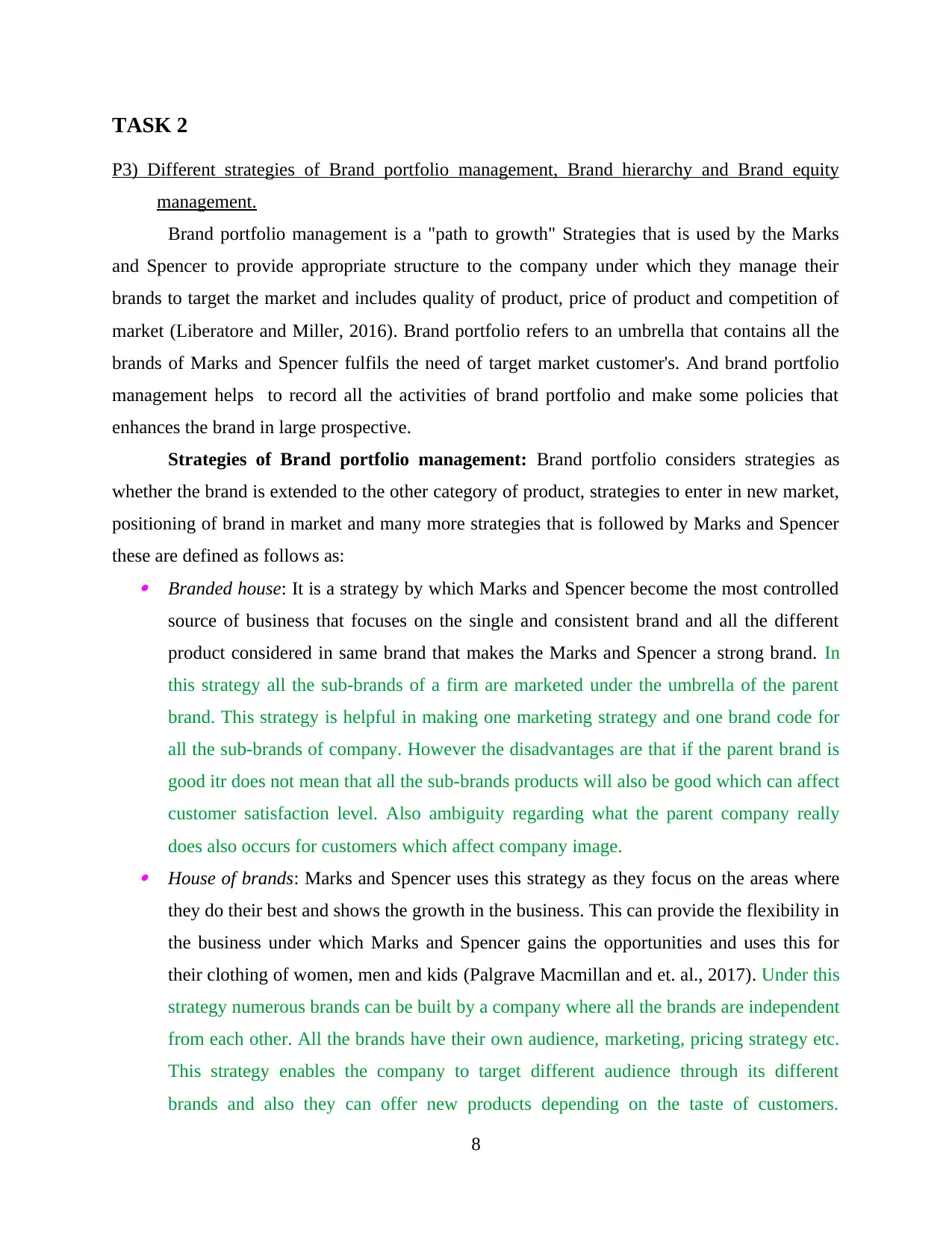
TASK 2
P3) Different strategies of Brand portfolio management, Brand hierarchy and Brand equity
management.
Brand portfolio management is a "path to growth" Strategies that is used by the Marks
and Spencer to provide appropriate structure to the company under which they manage their
brands to target the market and includes quality of product, price of product and competition of
market (Liberatore and Miller, 2016). Brand portfolio refers to an umbrella that contains all the
brands of Marks and Spencer fulfils the need of target market customer's. And brand portfolio
management helps to record all the activities of brand portfolio and make some policies that
enhances the brand in large prospective.
Strategies of Brand portfolio management: Brand portfolio considers strategies as
whether the brand is extended to the other category of product, strategies to enter in new market,
positioning of brand in market and many more strategies that is followed by Marks and Spencer
these are defined as follows as: Branded house: It is a strategy by which Marks and Spencer become the most controlled
source of business that focuses on the single and consistent brand and all the different
product considered in same brand that makes the Marks and Spencer a strong brand. In
this strategy all the sub-brands of a firm are marketed under the umbrella of the parent
brand. This strategy is helpful in making one marketing strategy and one brand code for
all the sub-brands of company. However the disadvantages are that if the parent brand is
good itr does not mean that all the sub-brands products will also be good which can affect
customer satisfaction level. Also ambiguity regarding what the parent company really
does also occurs for customers which affect company image. House of brands: Marks and Spencer uses this strategy as they focus on the areas where
they do their best and shows the growth in the business. This can provide the flexibility in
the business under which Marks and Spencer gains the opportunities and uses this for
their clothing of women, men and kids (Palgrave Macmillan and et. al., 2017). Under this
strategy numerous brands can be built by a company where all the brands are independent
from each other. All the brands have their own audience, marketing, pricing strategy etc.
This strategy enables the company to target different audience through its different
brands and also they can offer new products depending on the taste of customers.
8
P3) Different strategies of Brand portfolio management, Brand hierarchy and Brand equity
management.
Brand portfolio management is a "path to growth" Strategies that is used by the Marks
and Spencer to provide appropriate structure to the company under which they manage their
brands to target the market and includes quality of product, price of product and competition of
market (Liberatore and Miller, 2016). Brand portfolio refers to an umbrella that contains all the
brands of Marks and Spencer fulfils the need of target market customer's. And brand portfolio
management helps to record all the activities of brand portfolio and make some policies that
enhances the brand in large prospective.
Strategies of Brand portfolio management: Brand portfolio considers strategies as
whether the brand is extended to the other category of product, strategies to enter in new market,
positioning of brand in market and many more strategies that is followed by Marks and Spencer
these are defined as follows as: Branded house: It is a strategy by which Marks and Spencer become the most controlled
source of business that focuses on the single and consistent brand and all the different
product considered in same brand that makes the Marks and Spencer a strong brand. In
this strategy all the sub-brands of a firm are marketed under the umbrella of the parent
brand. This strategy is helpful in making one marketing strategy and one brand code for
all the sub-brands of company. However the disadvantages are that if the parent brand is
good itr does not mean that all the sub-brands products will also be good which can affect
customer satisfaction level. Also ambiguity regarding what the parent company really
does also occurs for customers which affect company image. House of brands: Marks and Spencer uses this strategy as they focus on the areas where
they do their best and shows the growth in the business. This can provide the flexibility in
the business under which Marks and Spencer gains the opportunities and uses this for
their clothing of women, men and kids (Palgrave Macmillan and et. al., 2017). Under this
strategy numerous brands can be built by a company where all the brands are independent
from each other. All the brands have their own audience, marketing, pricing strategy etc.
This strategy enables the company to target different audience through its different
brands and also they can offer new products depending on the taste of customers.
8
Paraphrase This Document
Need a fresh take? Get an instant paraphrase of this document with our AI Paraphraser
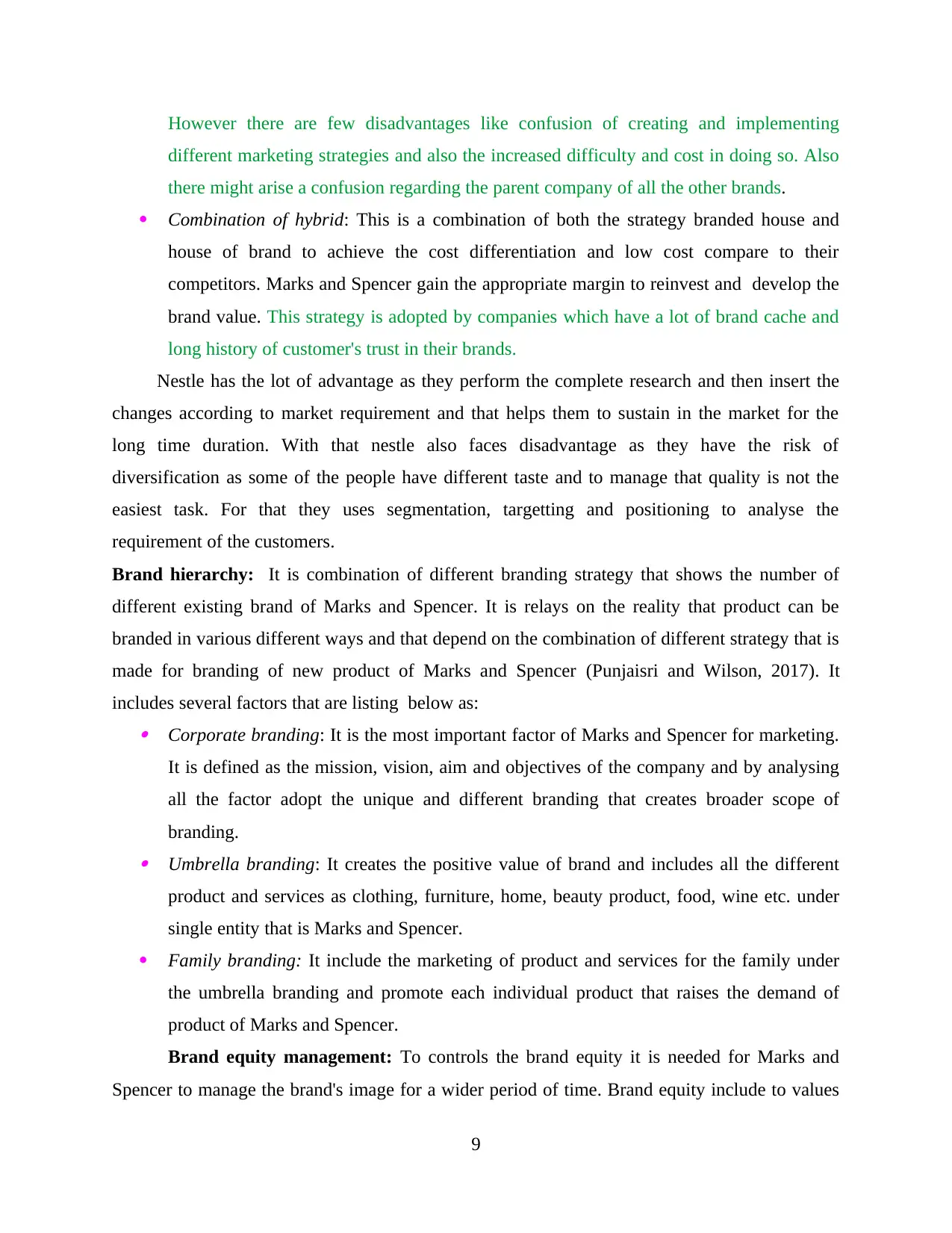
However there are few disadvantages like confusion of creating and implementing
different marketing strategies and also the increased difficulty and cost in doing so. Also
there might arise a confusion regarding the parent company of all the other brands.
Combination of hybrid: This is a combination of both the strategy branded house and
house of brand to achieve the cost differentiation and low cost compare to their
competitors. Marks and Spencer gain the appropriate margin to reinvest and develop the
brand value. This strategy is adopted by companies which have a lot of brand cache and
long history of customer's trust in their brands.
Nestle has the lot of advantage as they perform the complete research and then insert the
changes according to market requirement and that helps them to sustain in the market for the
long time duration. With that nestle also faces disadvantage as they have the risk of
diversification as some of the people have different taste and to manage that quality is not the
easiest task. For that they uses segmentation, targetting and positioning to analyse the
requirement of the customers.
Brand hierarchy: It is combination of different branding strategy that shows the number of
different existing brand of Marks and Spencer. It is relays on the reality that product can be
branded in various different ways and that depend on the combination of different strategy that is
made for branding of new product of Marks and Spencer (Punjaisri and Wilson, 2017). It
includes several factors that are listing below as: Corporate branding: It is the most important factor of Marks and Spencer for marketing.
It is defined as the mission, vision, aim and objectives of the company and by analysing
all the factor adopt the unique and different branding that creates broader scope of
branding. Umbrella branding: It creates the positive value of brand and includes all the different
product and services as clothing, furniture, home, beauty product, food, wine etc. under
single entity that is Marks and Spencer.
Family branding: It include the marketing of product and services for the family under
the umbrella branding and promote each individual product that raises the demand of
product of Marks and Spencer.
Brand equity management: To controls the brand equity it is needed for Marks and
Spencer to manage the brand's image for a wider period of time. Brand equity include to values
9
different marketing strategies and also the increased difficulty and cost in doing so. Also
there might arise a confusion regarding the parent company of all the other brands.
Combination of hybrid: This is a combination of both the strategy branded house and
house of brand to achieve the cost differentiation and low cost compare to their
competitors. Marks and Spencer gain the appropriate margin to reinvest and develop the
brand value. This strategy is adopted by companies which have a lot of brand cache and
long history of customer's trust in their brands.
Nestle has the lot of advantage as they perform the complete research and then insert the
changes according to market requirement and that helps them to sustain in the market for the
long time duration. With that nestle also faces disadvantage as they have the risk of
diversification as some of the people have different taste and to manage that quality is not the
easiest task. For that they uses segmentation, targetting and positioning to analyse the
requirement of the customers.
Brand hierarchy: It is combination of different branding strategy that shows the number of
different existing brand of Marks and Spencer. It is relays on the reality that product can be
branded in various different ways and that depend on the combination of different strategy that is
made for branding of new product of Marks and Spencer (Punjaisri and Wilson, 2017). It
includes several factors that are listing below as: Corporate branding: It is the most important factor of Marks and Spencer for marketing.
It is defined as the mission, vision, aim and objectives of the company and by analysing
all the factor adopt the unique and different branding that creates broader scope of
branding. Umbrella branding: It creates the positive value of brand and includes all the different
product and services as clothing, furniture, home, beauty product, food, wine etc. under
single entity that is Marks and Spencer.
Family branding: It include the marketing of product and services for the family under
the umbrella branding and promote each individual product that raises the demand of
product of Marks and Spencer.
Brand equity management: To controls the brand equity it is needed for Marks and
Spencer to manage the brand's image for a wider period of time. Brand equity include to values
9
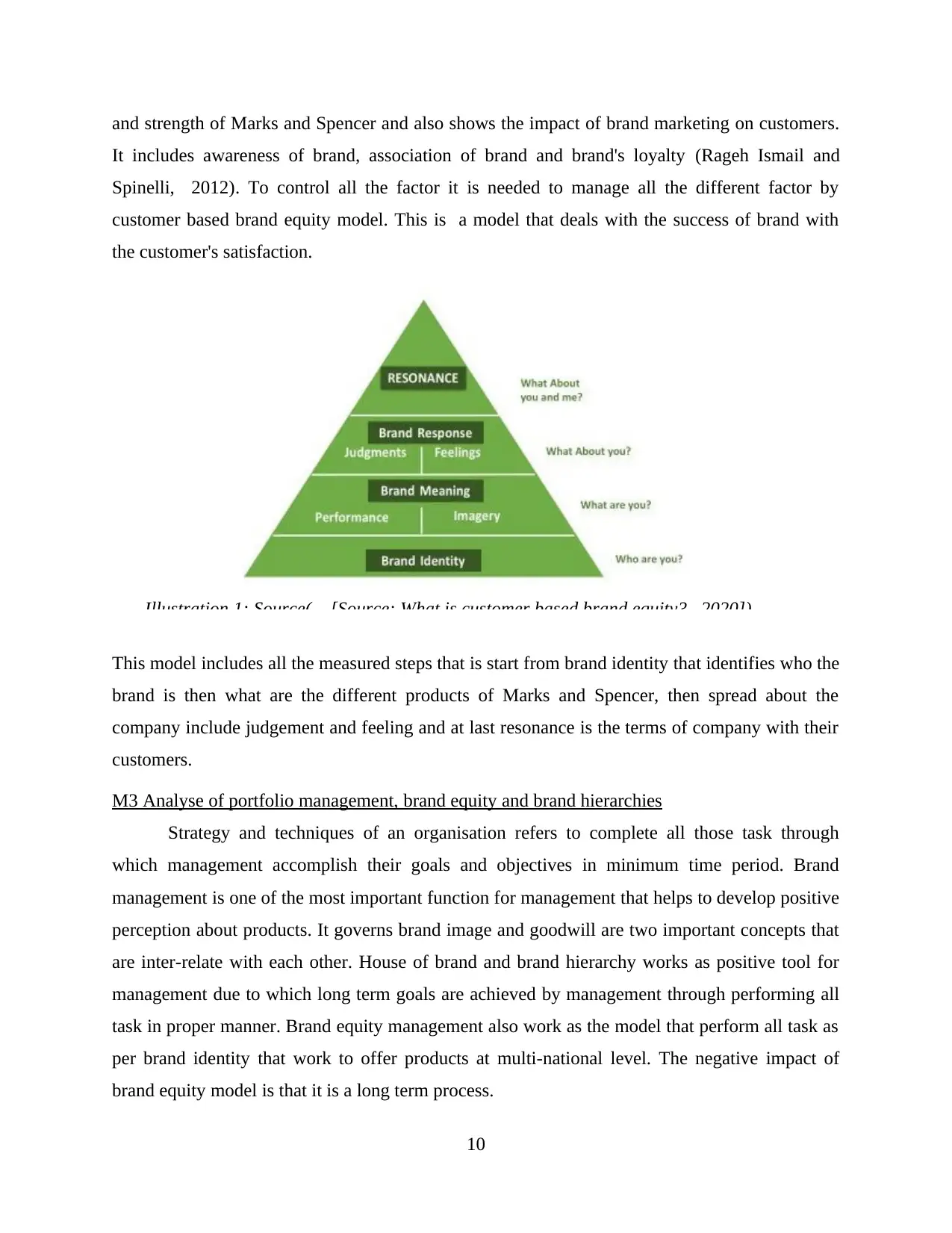
and strength of Marks and Spencer and also shows the impact of brand marketing on customers.
It includes awareness of brand, association of brand and brand's loyalty (Rageh Ismail and
Spinelli, 2012). To control all the factor it is needed to manage all the different factor by
customer based brand equity model. This is a model that deals with the success of brand with
the customer's satisfaction.
Illustration 1: Source( [Source: What is customer based brand equity? , 2020])
This model includes all the measured steps that is start from brand identity that identifies who the
brand is then what are the different products of Marks and Spencer, then spread about the
company include judgement and feeling and at last resonance is the terms of company with their
customers.
M3 Analyse of portfolio management, brand equity and brand hierarchies
Strategy and techniques of an organisation refers to complete all those task through
which management accomplish their goals and objectives in minimum time period. Brand
management is one of the most important function for management that helps to develop positive
perception about products. It governs brand image and goodwill are two important concepts that
are inter-relate with each other. House of brand and brand hierarchy works as positive tool for
management due to which long term goals are achieved by management through performing all
task in proper manner. Brand equity management also work as the model that perform all task as
per brand identity that work to offer products at multi-national level. The negative impact of
brand equity model is that it is a long term process.
10
It includes awareness of brand, association of brand and brand's loyalty (Rageh Ismail and
Spinelli, 2012). To control all the factor it is needed to manage all the different factor by
customer based brand equity model. This is a model that deals with the success of brand with
the customer's satisfaction.
Illustration 1: Source( [Source: What is customer based brand equity? , 2020])
This model includes all the measured steps that is start from brand identity that identifies who the
brand is then what are the different products of Marks and Spencer, then spread about the
company include judgement and feeling and at last resonance is the terms of company with their
customers.
M3 Analyse of portfolio management, brand equity and brand hierarchies
Strategy and techniques of an organisation refers to complete all those task through
which management accomplish their goals and objectives in minimum time period. Brand
management is one of the most important function for management that helps to develop positive
perception about products. It governs brand image and goodwill are two important concepts that
are inter-relate with each other. House of brand and brand hierarchy works as positive tool for
management due to which long term goals are achieved by management through performing all
task in proper manner. Brand equity management also work as the model that perform all task as
per brand identity that work to offer products at multi-national level. The negative impact of
brand equity model is that it is a long term process.
10
⊘ This is a preview!⊘
Do you want full access?
Subscribe today to unlock all pages.

Trusted by 1+ million students worldwide
1 out of 21
Related Documents
Your All-in-One AI-Powered Toolkit for Academic Success.
+13062052269
info@desklib.com
Available 24*7 on WhatsApp / Email
![[object Object]](/_next/static/media/star-bottom.7253800d.svg)
Unlock your academic potential
Copyright © 2020–2025 A2Z Services. All Rights Reserved. Developed and managed by ZUCOL.



